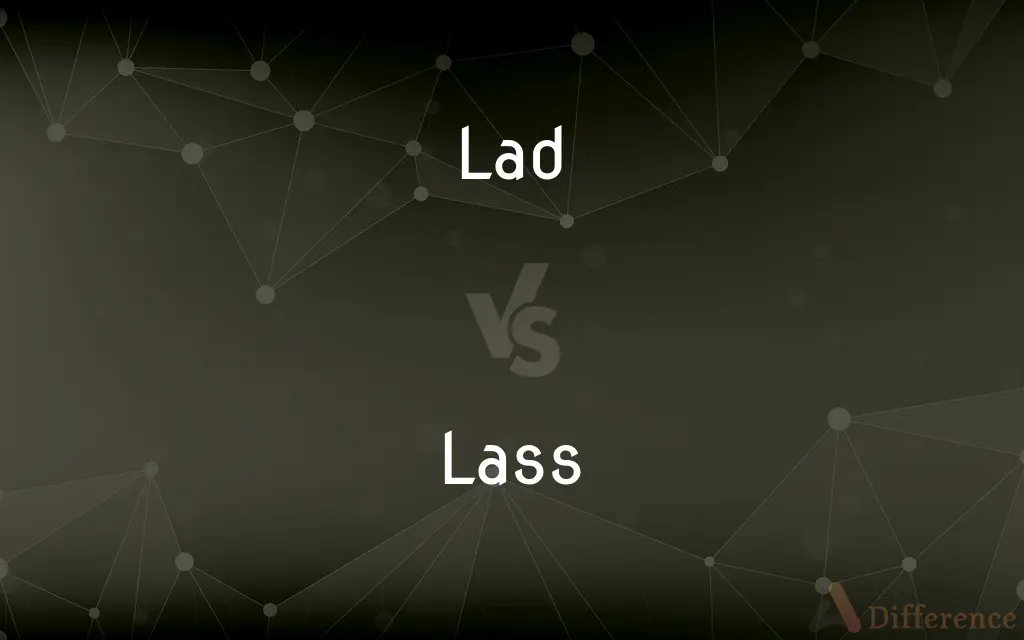Lad vs. Lass — What's the Difference?
By Fiza Rafique & Maham Liaqat — Updated on May 3, 2024
"Lad" refers to a young man or boy, often implying youthful energy, while "lass" denotes a young woman or girl, suggesting gentleness or sweetness.

Difference Between Lad and Lass
Table of Contents
ADVERTISEMENT
Key Differences
"Lad" is a term used primarily in British English to describe a young man or boy, often highlighting his youthfulness and energy. On the other hand, "lass" is used to refer to a young woman or girl, frequently emphasizing her youthful innocence and sweetness.
While "lad" can sometimes carry connotations of mischief or informality, implying a certain rough-and-tumble character, "lass" often conveys an image of demureness and charm, reflecting traditional feminine attributes.
In usage, "lad" is often colloquial and used informally among peers or in familial settings to address or refer to young males. Conversely, "lass" is similarly informal but might be used more endearingly to denote affection or tenderness toward young females.
Cultural representations also differ; "lad" is commonly associated with the archetype of a young, adventurous male in British folklore and stories. In contrast, "lass" is portrayed as the quintessential young, virtuous female in Scottish and English narratives.
In modern contexts, "lad" has evolved in some regions to describe a certain type of young male behavior, often related to being part of a group or "lad culture," which is sometimes marked by boisterous or rowdy behavior. Whereas, "lass" has not developed a similar cultural subtext and retains much of its traditional usage and connotation.
ADVERTISEMENT
Comparison Chart
Definition
Refers to a young man or boy
Refers to a young woman or girl
Connotations
Energy, mischief, informality
Sweetness, demureness, charm
Usage Context
Informal, colloquial, among peers
Informal, endearing, affectionate
Cultural Archetype
Adventurous, youthful male
Virtuous, charming young female
Modern Associations
Often linked with "lad culture"
Maintains traditional connotations
Compare with Definitions
Lad
Informally, a way to refer to a male youth or young man with a connotation of camaraderie.
He's a good lad, always ready to lend a hand.
Lass
Retains a more traditional usage without the modern cultural shifts seen in "lad."
The young lass from the countryside had a charm about her.
Lad
Used in contexts emphasizing youthful energy and sometimes mischief.
Those lads are always up to something.
Lass
A term used to describe a young woman or girl, particularly in Scottish and Northern English contexts.
The fair lass caught everyone's eye with her graceful dance.
Lad
A colloquial term often used affectionately to address younger males.
Come here, lad, and see what I've got for you.
Lass
Portrays an image of gentleness and traditional femininity.
Every tale in the village featured a brave lad and a gentle lass.
Lad
Can denote a male member of a peer group, especially in contexts of "lad culture."
He's become quite the lad since joining that group.
Lass
Used affectionately in informal settings to refer to young women.
Lass, can you help me with this task?
Lad
A term for a young man or boy, particularly in British English.
The young lad ran through the fields without a care.
Lass
Often connotes sweetness and youthfulness when referring to females.
She's a kind-hearted lass, always helping her friends.
Lad
A boy or young man.
Lass
A girl or young woman who is unmarried
Lad
(Informal) A man of any age; a fellow.
Lass
A girl or young woman
He married a lass from Yorkshire
Village lasses
Lad
A boy or young man.
Lass
A girl or young woman.
Lad
(British) A Jack the lad; a boyo.
I think he reckons he's a bit of a lad.
Last night I was out drinking with the lads.
Lass
A sweetheart.
Lad
A familiar term of address for a young man.
Come here, lad, and help me shift these boxes.
Lass
A young woman or girl.
Come and dance, ye lads and lasses!
Lad
A groom who works with horses.
Lass
A sweetheart.
Lad
The penis.
Lass
A young woman; a girl; a sweetheart.
Lad
A boy; a youth; a stripling.
There is a lad here, which hath five barley loaves and two small fishes.
Lad
A companion; a comrade; a mate.
Lad
A boy or man;
That chap is your host
There's a fellow at the door
He's a likable cuss
Lad
A male child (a familiar term of address to a boy)
Common Curiosities
What are the origins of the terms "lad" and "lass"?
Both terms originate from the Old Norse language, historically used to describe young persons in British Isles dialects.
How do the connotations of "lad" and "lass" differ?
"Lad" often connotes more energy and mischief, while "lass" suggests sweetness and gentleness.
Is "lad culture" negative?
"Lad culture" is sometimes criticized for promoting boisterous and unruly behavior, though it can also reflect camaraderie and group belonging.
Are "lad" and "lass" used in professional or formal settings?
Typically, both terms are reserved for more casual, colloquial contexts. Their usage in formal settings would be unusual and might be viewed as overly familiar or informal.
Can "lad" and "lass" be used for adults?
While typically used for younger individuals, both terms can be affectionately used for adults in a colloquial and familiar manner.
Do "lad" and "lass" have equivalent terms in other languages?
Many languages have informal terms for young people. For example, in Spanish, "chico" and "chica" are often used similarly.
Are there any popular cultural references that have popularized these terms?
Yes, many British TV shows, movies, and music references use "lad" and "lass" to evoke a sense of British identity or regional authenticity. Bands and television series from the UK often use these terms in their titles or lyrics.
Are there any movements or groups trying to redefine these terms?
While there's no widespread movement specifically aimed at redefining these terms, cultural shifts, especially around "lad culture," have sparked discussions about behavior and gender stereotypes associated with these terms.
How do younger generations perceive the terms "lad" and "lass"?
Younger people may view these terms with a sense of nostalgia or as part of traditional vernacular, particularly in areas where regional dialects are strong. However, some may also see "lad" as potentially derogatory due to its association with "lad culture."
What types of literature or media commonly use the terms "lad" and "lass"?
These terms are frequently found in folk tales, poetry, and songs from the British Isles, particularly those that reflect regional dialects and historical settings.
How have the perceptions of "lad" and "lass" changed over time?
Historically, both terms were straightforward descriptors of youth. However, "lad" has evolved in some contexts to include implications of specific group behaviors ("lad culture"), whereas "lass" has largely retained its traditional, more innocent connotations.
Can "lad" and "lass" be considered endearing when used?
Yes, in many contexts, these terms are used affectionately to express fondness and familiarity, particularly within families or among friends.
Is there an age limit for using "lad" and "lass"?
While there's no strict age limit, they are generally used for younger individuals. However, in a familial or affectionate context, they might be used for adults as a nod to their youth.
How do cultural differences within the UK affect the use of "lad" and "lass"?
Usage can vary significantly; for example, "lass" is much more common in Scotland and the North of England than in other parts of the UK. Similarly, "lad" might be used differently in various regions, reflecting local cultural nuances.
Share Your Discovery

Previous Comparison
Alphabetic vs. Alphabetical
Next Comparison
Rescission vs. TerminationAuthor Spotlight
Written by
Fiza RafiqueFiza Rafique is a skilled content writer at AskDifference.com, where she meticulously refines and enhances written pieces. Drawing from her vast editorial expertise, Fiza ensures clarity, accuracy, and precision in every article. Passionate about language, she continually seeks to elevate the quality of content for readers worldwide.
Co-written by
Maham Liaqat















































